|
The
|
|||
THE BURGENLAND BUNCH NEWS - No. 234 July 31, 2013, © 2013 by The Burgenland Bunch All rights reserved. Permission to copy excerpts granted if credit is provided. Editor: Thomas Steichen (email: tj.steichen@comcast.net) Our 17th Year. The Burgenland Bunch Newsletter is issued monthly online. It was founded by Gerald Berghold (who retired Summer 2008 and died in August 2008). |
|||
Current Status Of The BB: * Members: 2169 * Surname Entries: 7226 * Query Board Entries: 5178 * Staff Members: 17 |
|||
|
|||
1) THE PRESIDENT'S CORNER (by Tom Steichen)  This
is a newsletter of follow-ups! This
is a newsletter of follow-ups! After the Bits and Pieces in my President's Corner below, Fred Schneidinger provides our first full-length article, as he shares his Tagebuch (Day Book / Diary) from the first trip to Burgenland he took some 30 years ago this September. The diary was quite long so I planned to split it into two parts, one to run in the newsletter edition at the end of August—the other part at the end of September, thus surrounding the 30th anniversary of his trip. However, given I am not publishing an end-of-August edition (see notice in red above), the ends of July and September will serve instead. For Fred, putting the diary text and supporting pictures together for the newsletter was his personal follow-up... and we get to share. I "follow" that with another follow-up, this one prompted by messages from Barbara Csencsits, Robert Schatz and Wilhelm Schmidt concerning the report I did on Andrew Burghardt's book, Borderland. The third article, Hungarian Badges, is a follow-up to Newsletter 232's "An Austrian-Hungarian Badge." This time it is Mary Fuith, who reacted to the story of Robert Thullner's badge and provided some interesting badges of her own. The fourth article is a second follow-up to "Maria Hoffmann Hotwagner," first published in NL 231 and then followed up last month. This follow-up was motivated by Thomas Seltsam, who provides photographs of the Rechnitz military monuments (thanks Thomas!), which led to further research by me! The remaining articles are our standard sections: Historical Newsletter Articles, and the Ethnic Events and Emigrant Obituaries sections. Of course, our Historical Newsletter Articles are their own form of follow-up... as are Emigrant Obituaries (but see the obits as this was an unusual month!). But I start with some bits and pieces: 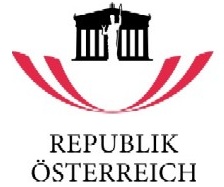 2013
PERSONAL STATUS LAW OF AUSTRIA: In Newsletter 225 (Oct 31, 2012), I reported concerns
about a rewrite of a law by the Austrian Parliament that could have been a disaster for
Austrian genealogical research. The draft law, known as the Personenstandsgesetz für
Österreich (Personal Status Law of Austria) was an update of a similar 1983 law.
Unfortunately, the rewrite dropped a paragraph of vital importance to genealogical research. 2013
PERSONAL STATUS LAW OF AUSTRIA: In Newsletter 225 (Oct 31, 2012), I reported concerns
about a rewrite of a law by the Austrian Parliament that could have been a disaster for
Austrian genealogical research. The draft law, known as the Personenstandsgesetz für
Österreich (Personal Status Law of Austria) was an update of a similar 1983 law.
Unfortunately, the rewrite dropped a paragraph of vital importance to genealogical research.The prior version of the law allowed open access to birth, marriage and death records older than 100 years; the new draft dropped this paragraph, meaning only records from before 1784 or about immediate relatives (by direct record request only, not by browsing) would be available. This, of course, would halt genealogical research of the nature usually undertaken by Burgenland Bunch members. The good news was that Felix Gundacker, a professional genealogist in Vienna, noted the omission of the paragraph and started a letter-writing campaign to amend the law (Klaus Gerger wrote a letter on behalf of the BB stating our position to the Austrian Parliament; we, of course, wanted access to be as open as possible). The outstanding news was that the campaign resulted in amendments that not only restored the previous right to access records, they improved access! The 2013 law was amended to continue restriction of birth records for 100 years but reduce the restricted period on marriage records to 75 years and on death records to 30 years. The follow-up is to report that Felix now tells us that the amendments were adopted and the new law is in effect. Thus, the new law allows many more records to be reviewable in parish registers and civil registry databases; a win for all of us!
The page goes on to note that most of these (and a few others) have "minority
self-government" groups.
Overall, this set of pages provides a Hungarian viewpoint on the ever-changing minority
situation in Vas County. It seems well worth reading, especially if your family lines cross
into present-day Vas County. |
|||
2) MEIN TAGEBUCH, 5-20 SEPT 1983, Part I (by Fred Schneidinger) 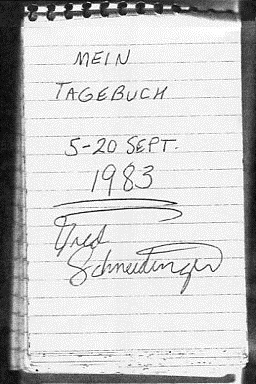 [Ed
Note: BB member Fred Schneidinger, of Schwenksville, PA, wrote to say he still had "the
diary from 30 years ago September when I visited my aunt and uncle in Vienna and Rotenturm; it
might be a good feature for the September issue if you think the membership would be
interested in that. I was a just a wide-eyed 20 year old Drexel student in Europe at that
time!" [Ed
Note: BB member Fred Schneidinger, of Schwenksville, PA, wrote to say he still had "the
diary from 30 years ago September when I visited my aunt and uncle in Vienna and Rotenturm; it
might be a good feature for the September issue if you think the membership would be
interested in that. I was a just a wide-eyed 20 year old Drexel student in Europe at that
time!"Well, I did think it would be of interest but, because it is quite long, the first part is presented below and the second part will be published in the next newsletter at the end of September. Part I tells of Fred's transit to Europe and his time in Vienna and Budapest. Part II of the diary begins when he first visits his ancestral village of Rotenturm in Oberwart and takes us through his return home. As you will read scattered within that travelogue, Fred speculates about his college education and future. He did, in fact, earn a Bachelor's degree in Business Administration and Management, married, had 3 children, and worked a short while for SEPTA (see below) before making a career as a Train Dispatcher for AMTRAK (I guess he was serious about hating airports and wanting a railroad-oriented job!). In 1995, he also started his own agricultural-related company (another interest), which grows specialty trees for resale in the nursery industry. Now the question is, did he ever get back to Rotenturm?] Here is Part I of the transcript of Fred's 1983 diary.... Sept 5, 1983, Sunday  I
couldn't sleep too well after I awoke this morning at 7 am. This would be a long day; indeed,
one of the longest. I now sit aboard an extremely wide 747 jet [at the Philadelphia
airport], ready to head off to Europe. It's a bit past 9 pm and I'll be taking off any
time now. Today was a day in waiting. I didn't drive anywhere at all. I did run around the
block, though, for my last exercise in a while. More and more I think exercise is so important
even if one doesn't go to a gym or play football, etc. I
couldn't sleep too well after I awoke this morning at 7 am. This would be a long day; indeed,
one of the longest. I now sit aboard an extremely wide 747 jet [at the Philadelphia
airport], ready to head off to Europe. It's a bit past 9 pm and I'll be taking off any
time now. Today was a day in waiting. I didn't drive anywhere at all. I did run around the
block, though, for my last exercise in a while. More and more I think exercise is so important
even if one doesn't go to a gym or play football, etc.We are moving now. Backwards. Maybe forwards. Now we're given instructions for possible trouble. Life rafts, oxygen masks, etc. We'll be going to Kennedy Airport in New York first. I just learned I'm in a hurry. When I think about the long trips on ships that my ancestors came over on, an 8-hour plane ride is nothing. We're taxiing out to the runway now. I have a window seat. This plane is rather empty considering it's immense size. So empty that I'm alone in this row and not making much conversation. I last talked to Mom and Dad when I said "goodbye." It's a shame nobody could come with me. It's really an eventful trip for the Schneidinger family. I think an ongoing communication between European and American Schneidingers is just great. HERE WE GO! I'm on the wing... there goes America... well at least Philadelphia. Now we are circling over the city, but still climbing. You don't know you have something 'till its gone and sometimes it takes a trip like this to realize how lucky I am. Hopefully things will be more in perspective when I return... Well we're coming down on NY at 9:53 pm about 25 minutes after we took off from Philadelphia. That was fast. Quicker than it takes the Lansdale local SEPTA train to get to Jenkintown [two towns in the northern Philadelphia suburbs, about 15 miles apart]. The lights of New York are just dazzling. I'm not nervous a bit, even though there's some shaky spots. I'm a little anxious about the whole experience, though; this is the biggest thing I've done yet and I think I deserve it since sometimes my life has been boring. LANDING... and what a landing it was. I've been on a flight before to Florida on my senior class trip that was pretty fun. But so much has changed since those high school days... much for the better. Drexel [University, in Philadelphia] has been a good experience for me and the job experiences are invaluable. I have always been a work-oriented person. Hard work keeps a man healthy and thinking clearly. Sometimes "think jobs" or tedious jobs can have the opposite effect. I want a job that I can be proud of. Having my own Agway [a retail agricultural business] or whatever would be ideal. SEPTA [Southeastern Pennsylvania Transportation Authority] is good, especially if I can land a railroad-oriented job. And who knows what CIA will bring. I just want to keep my options open and I think I can. As for my major, I'll decide shortly after I get back. We're still taxiing at NY but I can see buildings so soon we should be unloading. (Those going to Frankfurt stay on.) I did have a good summer. School wasn't so bad after all, especially with this trip to look forward to. Now I can't believe I'm on my way. I was glad to see Bob [a friend] before I left. He's a good guy and a good friend. Many are getting off now. There will be people getting on now, also. I hope I have some conversation soon. I do want to get some sleep so I don't get jet lag on Wed. morning. We'll be sitting here for a while so I'm going to get a drink. And now we are moving again at 11:30 pm. Again more instructions. It's been a long day. Off to Europe! 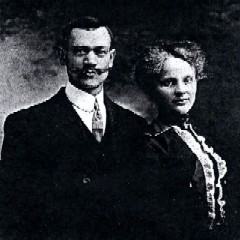 It's
5 am American time and we're at 37,000 feet doing 625 mph over Ireland. In about an hour we'll
be at our destination. I slept on and off most of the night. I feel rested but my ears are a
little tight because of the altitude. I skipped their dinner meal so I'm going to have
breakfast now. They say the weather's really nice down there. Most of the people on the plane
are older. By now I guess everyone at home is just getting up. Today I'll probably hang around
Frankfurt all day and find out some train info. I have no idea what to expect. I hope my
luggage doesn't take too long. I hate airports... It's
5 am American time and we're at 37,000 feet doing 625 mph over Ireland. In about an hour we'll
be at our destination. I slept on and off most of the night. I feel rested but my ears are a
little tight because of the altitude. I skipped their dinner meal so I'm going to have
breakfast now. They say the weather's really nice down there. Most of the people on the plane
are older. By now I guess everyone at home is just getting up. Today I'll probably hang around
Frankfurt all day and find out some train info. I have no idea what to expect. I hope my
luggage doesn't take too long. I hate airports...We were over London just a while ago so now we must be over France... Sometimes one cannot realize something exists 'till we see it ourselves. Now I'm seeing Europe at last and we're circling around Frankfurt, Germany. All the history classes in the world wouldn't add up to this... landing on German soil and seeing it for myself. I can see cars and read German signs now... we'll land very soon. Fields and highways... here we are on German soil! 12:30 pm, Sept 6, 1983. Sept 6, 1983, Monday 3:10 pm. Well I've just changed trains in Würzburg. It's unbelievable but I actually made the 1:30 pm train out of Frankfurt. The plane was early to begin with and I got my baggage right away and caught the "subway" to the Main "Bahnhof." It's a station similar to the Reading Terminal [in Philadelphia] and I caught the train with minutes to spare. That train was different. On one side is an isle with windows that can be opened and on the other side was compartments with room for 6. Across from me was an older lady and by the window was an older couple. The lady by the window had some whiskey in a bottle that she sipped from. The train took a while to get out of Frankfurt but was very fast on the countryside. The conductor came by and spoke in German. I had to pay 6 Marks extra for some reason. After that, I stood up and looked out the window. The villages were just as I'd expected. The train was very impressive. One could poke his head out the window and see front and back. All the people around me were usually speaking in German and laughing one in a while "ya-ya-ya." It's just what I'd thought. The train sped east and would have come close to the Iron Curtain but it went southward towards Würzburg. I hope they don't ask me for more Marks because I'm running low. I'll breathe easier when I reach the Austrian frontier. I'll get to Vienna at 9:30 pm according to the good lady's schedule (the one across from me on the other train). 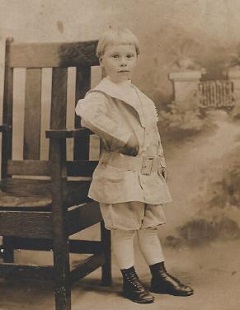 Now
I'm on another train more American-like. There's a lot of open spaces out there. It's really
nice country. I have to make another change at Passau. It's all happening so fast! I only
really took off 12 hours ago. Every village has its own character. They come around with carts
full of beer and coffee on the train but I can't spend it now. They have Fanta soda here, too.
Here comes the conductor again! Now
I'm on another train more American-like. There's a lot of open spaces out there. It's really
nice country. I have to make another change at Passau. It's all happening so fast! I only
really took off 12 hours ago. Every village has its own character. They come around with carts
full of beer and coffee on the train but I can't spend it now. They have Fanta soda here, too.
Here comes the conductor again!Well I didn't have to pay anything that time. It's about 4:45 now and we're still moving along towards the Austrian frontier. I'm making good time; the trip from Harleysville to Vienna will be about 21 1/2 hours. I don't think I'll have to change trains. That Passau is only a border town where they'll check our passports. I think we're near the Czech Iron Curtain now by the looks of my map and the scenery. I'm going to try calling home tonight without being charged by Austria's phone company, which is very expensive. I'm getting hungry. That plane food just doesn't make it. Well we just got to Passau and it's 6:15 pm. This is the border town on the Danube River. The Polizei already checked passports way back in Germany though. Yep, I can see the river they named the song after, although the water isn't too blue. I didn't have to change trains again. I managed to find that out from some older ladies in front of me. There wasn't much of a border to cross. Here there are Austrian trains and German trains. The train is emptier now. Here we go. It's 6:24. The last leg. I'll try and sleep awhile. Well, I can't sleep. This is Austria now; they've changed conductors at the border. It's getting a little dark now, It's a little cloudy too. Linns, 7:30 pm: Now we are deep into Austria only a little west of Vienna. When I look on the map, it's surprising, since we are actually east of East Germany and Czechoslovakia. This country is truly a western outpost in Central Europe. I've been dozing off every now and again. I'm tired and hungry. Now it's coming upon 9 pm and it's dark outside now. I think it's the last stop 'till Vienna now. The train doesn't slow down but just keeps rolling eastward. I fell asleep for a 1/2 hour... deep sleep. I must be tired. It was a long day. Soon I will meet my near-lost relatives. I hope it is a good trip. The first part of it was good. Sept 7, 1983, Tuesday 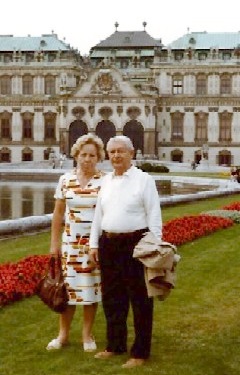 Now
I'm finally here and I got a good night's rest. I got to the train station and called Peter
[Schneidinger, a second cousin to Fred's father but closer in age to Fred], but he wasn't
home. Then I called Loisl [Schneidinger, a great-uncle to Fred and an uncle to Peter]
and he told me to take a taxi. When I got here, they were all standing outside and promptly
paid my taxi fare. They took me to their modest apartment and gave me a beer and some ham and
eggs, bread and tomatoes. I am communicating with them very well. They are very nice and very
happy-go-lucky. Peter called and talked to me for a while also. I showed them the photos and
let them hear the tape of Mom and Dad. They showed me some pictures and also some documents
from the war. I explained to them that I should call my parents and I finally got a hold of
them at 10 of midnight. They were tired and wanted to get to bed so they showed me a room
downstairs where I would stay. I have a room by myself but I think an older lady lives in the
apartment. Relli [wife of Loisl] got me tickets to see the Pope on Friday since he will
be in Wien then. That alone would make this trip more than worthwhile. They also said that
Peter would go with me to Hungary, and someone else with me to Burgenland, which is where the
Schneidingers came from. Loisl was born in Vienna but his father was in America in 1905-6
(Ambler [in Pennsylvania north of Philadelphia]). I found that very interesting. Relli
was born in Czechoslovakia and both went to Poland during the war in 1941. They remember dad
really well it seems. They can't believe its been 30 years. Well I hope I like it here. It's
cloudy today. Hope it clears up for some photos. Now
I'm finally here and I got a good night's rest. I got to the train station and called Peter
[Schneidinger, a second cousin to Fred's father but closer in age to Fred], but he wasn't
home. Then I called Loisl [Schneidinger, a great-uncle to Fred and an uncle to Peter]
and he told me to take a taxi. When I got here, they were all standing outside and promptly
paid my taxi fare. They took me to their modest apartment and gave me a beer and some ham and
eggs, bread and tomatoes. I am communicating with them very well. They are very nice and very
happy-go-lucky. Peter called and talked to me for a while also. I showed them the photos and
let them hear the tape of Mom and Dad. They showed me some pictures and also some documents
from the war. I explained to them that I should call my parents and I finally got a hold of
them at 10 of midnight. They were tired and wanted to get to bed so they showed me a room
downstairs where I would stay. I have a room by myself but I think an older lady lives in the
apartment. Relli [wife of Loisl] got me tickets to see the Pope on Friday since he will
be in Wien then. That alone would make this trip more than worthwhile. They also said that
Peter would go with me to Hungary, and someone else with me to Burgenland, which is where the
Schneidingers came from. Loisl was born in Vienna but his father was in America in 1905-6
(Ambler [in Pennsylvania north of Philadelphia]). I found that very interesting. Relli
was born in Czechoslovakia and both went to Poland during the war in 1941. They remember dad
really well it seems. They can't believe its been 30 years. Well I hope I like it here. It's
cloudy today. Hope it clears up for some photos.I woke up at about 7 am this morning and arranged my things in my bedroom. Relli made me ham and eggs for breakfast and then she took me out for a day in Wien. It was a short trolley ride away to the center of the town. When we got there I saw St. Stephens [cathedral], the Hofburg, the Kaiser crypt, many old churches and government buildings, and the Papal platform for Sunday Mass. Relli can only speak German and myself basically English but we managed to communicate well. People seem to have a different attitude here about strangers. Relli has no qualms in carrying on a conversation with a stranger. It's good if the stranger knows English because Relli will tell her stories about old Vienna, the stranger laughs, then tells me and I laugh. She is very well-read. I think she was a librarian at one time. She was born in Czechoslovakia. Loisl has traveled to France, USSR and Poland. Relli bought me lunch in an ancient monk-rectory. Everything is so old here! Many things before Columbus even came to America. We saw an ancient chapel (1200's) uncovered when the subway (U-Bahn) was built. St. Stephens is magnificent. So is the Opera House. And the crypt where all the Kaisers are kept in wooden coffins in rows (their hearts and organs were cut out and buried under St. Stephens). Finally, we got back to Hofmannthalgasse and had supper when Peter arrived. Peter seems nice. He showed me photos of him and his girlfriend. (I didn't meet her or his mother yet.) He drives a nice car. We will go to Hungary tomorrow, crossing the Iron Curtain at Sopron. Friday we will see the Pope and next week the Alps and Burgenland. Loisl is another John Fassl "Funny Man" [Fred's great uncle, emigrated from Rotenturm]. He's always laughing and joking. Relli is fun too. Sometimes they talk and laugh and I can't keep up. They talk about me, I think. Relli made a great dinner of chicken and potatoes and tomatoes. Then came dessert. They have one meal a day -- all day! Österreichers. After dinner, Relli showed me a book about the history of Austria and also Johann Strauss. They are very open and frank about Hitler and "die Russen" in the east. More tomorrow! They are very neat and clean. Sept 8, 1983, Wednesday 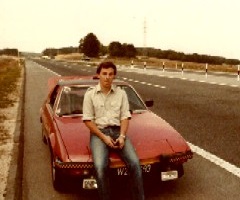 Today
me and Peter went to Hungary in his eye-catching Fiat. We left here about 9 am and were there
(Budapest) about 1 pm. It started out as a ride through Burgenland but finally we came upon
the Iron Curtain. [Ed Note: Peter and Fred passed through Burgenland's Neusiedl am
See district, north of the Neusiedlersee, as that is the path of the Ost Autobahn between
Vienna & Budapest. However, Fred's ancestral roots are in Oberwart, a district very different
from Neusiedl.] Peter had to get a visa. We passed through the checkpoint Hegyeshalom.
Vienna and Austria are just beautiful but Budapest and Hungary are a bit grim, although the
people seem to be dressed well. Mostly they drive Russian Ladas or else ride bikes (old black
ones!). On the road to Budapest (which is a good highway through farmlands and towns - very
small) we stopped and had a beer and we took some photos. Relli told me not to take camera to
Hungary (so I didn't). "Nicht ist gut!" she said. On we went and were in Budapest very
fast. (The way Peter drives!) We walked around the north side of the river (I don't know if
that's Buda or Pest) and eventually ate lunch there. Peter didn't speak Hungarian or Russian
but the menu had German and so did the waitress and host. The restaurant was close to the
Parliament building. The crowd in the restaurant were mostly workers, save a bunch of noisy
Italians. I ordered what he ordered and it was a Turkish meal of chicken with cheese and
vegetables (and of course Brot and Bier). We drove across the river and I bought some
Hungarian crystal. (Actually, Peter bought it and when I got home, Relli said it was a gift
for mom and dad). I also bought some copper and glass pieces. Then we were off, back to
Vienna. Peter isn't interested in culture it seems. I guess when you're at the center of
culture, you take it for granted. Today
me and Peter went to Hungary in his eye-catching Fiat. We left here about 9 am and were there
(Budapest) about 1 pm. It started out as a ride through Burgenland but finally we came upon
the Iron Curtain. [Ed Note: Peter and Fred passed through Burgenland's Neusiedl am
See district, north of the Neusiedlersee, as that is the path of the Ost Autobahn between
Vienna & Budapest. However, Fred's ancestral roots are in Oberwart, a district very different
from Neusiedl.] Peter had to get a visa. We passed through the checkpoint Hegyeshalom.
Vienna and Austria are just beautiful but Budapest and Hungary are a bit grim, although the
people seem to be dressed well. Mostly they drive Russian Ladas or else ride bikes (old black
ones!). On the road to Budapest (which is a good highway through farmlands and towns - very
small) we stopped and had a beer and we took some photos. Relli told me not to take camera to
Hungary (so I didn't). "Nicht ist gut!" she said. On we went and were in Budapest very
fast. (The way Peter drives!) We walked around the north side of the river (I don't know if
that's Buda or Pest) and eventually ate lunch there. Peter didn't speak Hungarian or Russian
but the menu had German and so did the waitress and host. The restaurant was close to the
Parliament building. The crowd in the restaurant were mostly workers, save a bunch of noisy
Italians. I ordered what he ordered and it was a Turkish meal of chicken with cheese and
vegetables (and of course Brot and Bier). We drove across the river and I bought some
Hungarian crystal. (Actually, Peter bought it and when I got home, Relli said it was a gift
for mom and dad). I also bought some copper and glass pieces. Then we were off, back to
Vienna. Peter isn't interested in culture it seems. I guess when you're at the center of
culture, you take it for granted.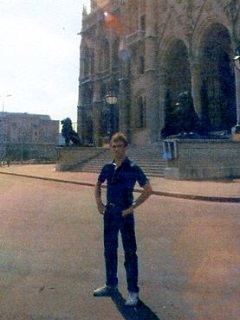 We
saw some Hungarian soldiers and I think some Russian soldiers (always the Red Stars on their
hats and belts). Peter told me about how he was in the modest Austrian Air force (32 planes,
150 helicopters; better than their modest navy: 2 ships and 2 guns!) He is a 2nd lieutenant
co-pilot in the Air Force; he said that Austria wants to stay neutral for a long time. I don't
blame them. What I've seen has radically challenged some of my views. Of course, they do pay
1/3 income in taxes. But they don't want and don't live beyond their means. I haven't seen a
Philadelphia in Österreich yet. But we were driving along and I looked around Hungarian fields
and towns and said a prayer that some day they will be free. In the past 3 months, many
Hungarians have fled over the Curtain in crop dusters. Just tonight on the news some Czechs
came over in a plane. I said a prayer that there will be no Iron Curtain. Tear it down!
Österreichers, Hungarish -- we're all the same. There's no need for it. We
saw some Hungarian soldiers and I think some Russian soldiers (always the Red Stars on their
hats and belts). Peter told me about how he was in the modest Austrian Air force (32 planes,
150 helicopters; better than their modest navy: 2 ships and 2 guns!) He is a 2nd lieutenant
co-pilot in the Air Force; he said that Austria wants to stay neutral for a long time. I don't
blame them. What I've seen has radically challenged some of my views. Of course, they do pay
1/3 income in taxes. But they don't want and don't live beyond their means. I haven't seen a
Philadelphia in Österreich yet. But we were driving along and I looked around Hungarian fields
and towns and said a prayer that some day they will be free. In the past 3 months, many
Hungarians have fled over the Curtain in crop dusters. Just tonight on the news some Czechs
came over in a plane. I said a prayer that there will be no Iron Curtain. Tear it down!
Österreichers, Hungarish -- we're all the same. There's no need for it.But it's a reality and reality set in as we approached it from the East this time. What if I was a young Hungarian? How would I feel as I approached this barbed wire and tower and dogs? I must say it's futile. First comes the Iron Curtain, the physical Iron Curtain... five feet high and barbed wire. The gentleman with the Russian machine gun checks your passport there. Then to the gate where there is communicated an "OK" from the first barrier. Then comes the turnpike-type building where we got out and some green and red clad soldiers check trunks, pop-up campers and bus luggage carriers. These guards only have side arms. Then they take the passport and give it to the "turnpike guard"! 20 minutes later the passport is given back. But in German the guard told Peter to get rid of the Hungarian money left over before we could leave. Peter went and bought a bottle of brandy. Meanwhile I went to see if I could find a postcard but apparently went the wrong way. "Psst -- -- -- Hungarian," I heard behind me. The good guard guides me the right way after I whipped out my passport. Peter came out and we drove to another gate zigzag. The good lady with the machine gun checked our passports and we were on our way to one more tower and then after they checked us again I saw the Austrian flag. "Österreich?" I asked Peter. "Ya, Österreich," he said and we both breathed a sigh of relief. I was "home" again. It could be my home very easily and I don't think I'd regret it. Hungary and America are opposites but they have some things in common. Austria is somewhere in-between and I like something about that. Such is Hungary. But history is longer than since 1945 and things will change there. I hope. And I hope some things change in America also. We got back and Relli had made some Kuchen (cake) and we ate it. Am learning German little by little by listening and I can communicate OK. Peter is rather quiet but very nice. I expected many questions about America. I asked the questions and put in my 2 cents about America. Loisl is a charmer. The way he laughs and says "oh fret, fret." They want me to come back when I get married. he sang an Italian opera piece tonight and then we said goodnight. Gut Nacht! Sept 9, 1983, Thursday It's midnight and I wasn't as busy today but I still am getting to bed late. After the usual egg breakfast, Relli took me to the Spanish Riding School by bus. Then she went back home and, for the first time, I was alone on my own in Wien. I started to walk towards St. Stephens, since the practice for horses wasn't until 10 o'clock am. I got to St. Stephens but couldn't find my way back too easy. There's not a straight street in Wien. But it was a nice walk. I saw many "polizei" and soldiers getting ready for the Pope's visit tomorrow. I got back in time and met two English-speakers in line... one American. It was good speaking English just for once. I stuck with them for a good part of the day. I liked the horse show; nothing like American horsemanship (at least mine). After, we went to the Museum of Art, where I saw many old pictures from the Renaissance, and also the crown jewels and robe of the Hapsburg emperors. After, we went to an outdoor cafe and I had spaghetti and a beer. I wrote some postcards and spoke to these Americans who were the Harvard high-minded types, if you know what I mean. But we talked and I found it interesting. 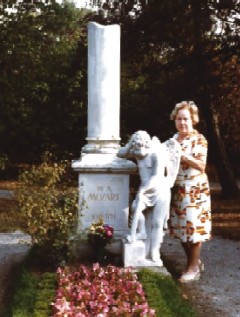 I
went back home at about 4 and Relli took me out to a graveyard in the back of their apartment.
Mozart and many of his teachers are buried there. How would you like to have Mozart buried in
your backyard? Such is Vienna. Then we went back for Loisl and we went to the Belvedere Palace
by streetcar. It is also beautiful and one has a good view of the city there. I snapped some
photos of Loisl and Relli there. Loisl went back home and Relli took me around some more to
see a Polish Church along the Papal route and also the French and Swiss embassies, where
Austrian guards are outside and no American guards. The Austrians are proud of their
neutrality. Also saw a monument the Russians made when they were here between '45 and '55.
They even named a street Stalingasse but the Austrians changed that back when the
Russians left. We went back then by subway, which is a neat system. After a wurst supper, we
watched TV for a while. And I did some reading. Loisl is very funny. He likes to imitate
Russians (he was in the German Army in the second world war). I saw some old pictures of Loisl
tonight, too. I realized after the call how different the whole psychology seems to be over
here. There's much less worry and much more hope over here, I think. I guess us Americans are
still trying to be the world policemen and not stay out of costly conflicts. The Austrians do
have a point. I
went back home at about 4 and Relli took me out to a graveyard in the back of their apartment.
Mozart and many of his teachers are buried there. How would you like to have Mozart buried in
your backyard? Such is Vienna. Then we went back for Loisl and we went to the Belvedere Palace
by streetcar. It is also beautiful and one has a good view of the city there. I snapped some
photos of Loisl and Relli there. Loisl went back home and Relli took me around some more to
see a Polish Church along the Papal route and also the French and Swiss embassies, where
Austrian guards are outside and no American guards. The Austrians are proud of their
neutrality. Also saw a monument the Russians made when they were here between '45 and '55.
They even named a street Stalingasse but the Austrians changed that back when the
Russians left. We went back then by subway, which is a neat system. After a wurst supper, we
watched TV for a while. And I did some reading. Loisl is very funny. He likes to imitate
Russians (he was in the German Army in the second world war). I saw some old pictures of Loisl
tonight, too. I realized after the call how different the whole psychology seems to be over
here. There's much less worry and much more hope over here, I think. I guess us Americans are
still trying to be the world policemen and not stay out of costly conflicts. The Austrians do
have a point.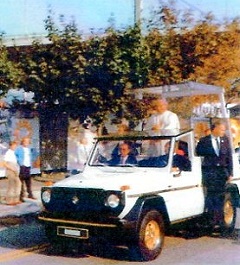 Sept
10, 1983, Friday Sept
10, 1983, FridayToday I finally saw the Pope and the sight of him brought his being into a different perspective. He wasn't coming over the TV, he was there. I saw him on 3 occasions today: First, in the Popemobile on the unbelievably empty Lanstrasse route. Then Relli and I followed him to the Hofburg, where he made a speech with all the Cardinals and Gov't officials there. Then, just an hour ago, I saw him at the stadium for a young people's speech. This speech was (or seemed to be!) good, but I think my Austrian comrades could have put on a better performance for him. I'm getting around on my own pretty good now. This morning, Loisl drove me to the Military Museum, which was pretty interesting. Loisl is very happy-go-lucky and likes to poke fun at my German: ya, ya, ya.... Sept 11, 1983, Saturday Today I was up early, as usual, and Relli and I went to the Papal Mass at the new UN Complex. It rained on and off pretty hard and we were pretty wet. But the voice of the Pope was so clear and so strong that one forgot about the rain. After mass we came back and I didn't do much for the rest of the day. I wrote 2 letters and called home and looked at an art book, with Aunt Relli explaining all the pictures. Sept 12, 1983, Sunday I felt well rested for the first time when I got up this morning. I went to the Belvedere Palace for a tour this morning, but it was closed, and I ended up listening to some English tour guides outside the Palace before going down to the center of the town. I got to St. Stephens in a 1/2 hour, just in time for noon mass. I can follow the German mass rather well. Then I went out and bought some souvenirs on the street and took some photos. The town is very interesting and very busy. I went back home and Aunt and Uncle and I went out to the graveyard in the city where Beethoven and Strauss and Schneidinger is buried. Loisl's mother is buried there, but there is room for Loisl and Relli at the grave, too. His mother died at 90 in '72. I also saw the graves of the 1927 Viennese Revolution as well as the world war graves. All the young men there, Europe's strength, Europe's hope, perished in a senseless series of wars perpetuated by greed and hatred. I pray that Europe and America never see such wars again. But I am afraid it might all be in vain because the one thing I've learned here is that history is very long and full of peaceful times followed by war and destruction. I hope I am wrong. We went shopping after; Relli just about broke my hand when I reached for my wallet to help pay for some of the food I've been consuming. 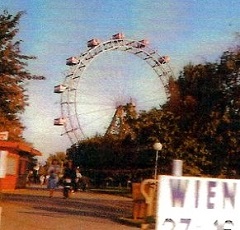 Tonight we went to the famous Pratter Ferris Wheel in the Donau Park. We went with the girl next door, who's had some English. The Ferris Wheel has gondolas and is slow-moving, so one can see Vienna by night. After, we went to a Park restaurant (eat, eat, eat, even in the supermarket there's a restaurant) and Relli talked and I asked questions and the girl attempted to translate. She did pretty good until she said that Relli worked in a business where she sold "enemas." I almost died when I found out she meant "animals." I never laughed so hard... when I got back I showed them in the dictionary why I was laughing. She's kind of cute. Relli explained to me, through her, some of the problems in the family with Loisl and Loisl's sister. I guess every family has their little traits. I'm starting to think of home a little bit more. And I get a better perspective now. Sept 13, 1983, Monday 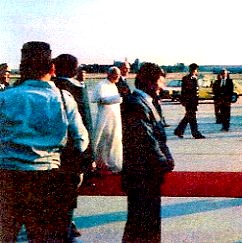 Today was a day that I'll never forget. Not because I went to the Belvedere Palace or the Folks opera, but because I went to the airport to see the Pope off and, for a moment, a short joyous moment, he held his hand on mine.... I touched the Pope of Rome... the successor of St. Peter! The man who demands attention from Presidents and Premiers, the man who is the symbol of Christendom throughout the world. I wanted to say something but I just froze and then went away misty-eyed and with a genuine smile... I touched John Paul II! I still can hardly believe it. I thought it was great just to see him in person this week... in the back of my mind I toyed with the thought of this happening... and now it has. It's the ultimate. I will always remember this day and ponder its meaning. I can't say much more about September 13, 1983! [Ed Note: Part II of Fred's Diary will be presented in the next newsletter at the end of September. Join Fred as he visits his ancestral village of Rotenturm in Oberwart.] |
|||
3) BOOK REPORT: "BORDERLAND" FOLLOW-UP 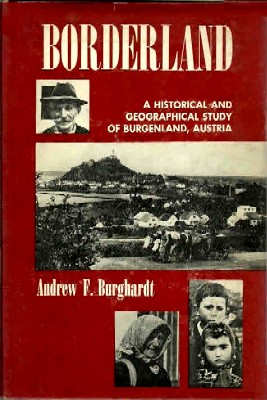 Last
month, I wrote a report on Andrew F Burghardt's 1962 book, Borderland: A Historical and
Geographical Study of Burgenland, Austria (University of Wisconsin Press). That report
garnered some interest in the newsletter readership. Last
month, I wrote a report on Andrew F Burghardt's 1962 book, Borderland: A Historical and
Geographical Study of Burgenland, Austria (University of Wisconsin Press). That report
garnered some interest in the newsletter readership. One message asked about creating an electronic copy of the book... Brenda Csencsits writes (in part): Dear Tom, I enjoyed the review of "Borderland" by Andrew F. Burghardt in the current BB newsletter and would like to have a copy of the book for myself. It seems they are hard to come by for a reasonable price. That got me to thinking, perhaps the book can be digitized and made available as an e-book or on-line on the internet. ... A survey of the BB membership could indicate how many people would be interested in an electronic version of the book. Perhaps someone can take this on as a project. "Borderland" seems like a good reference book and it would be a shame for it to disappear. Thank you for your consideration, Tom. I replied: Hi Brenda, unfortunately, Borderland's copyright (held by the Regents of the University of Wisconsin) was renewed in 1990, so it will not enter the public domain until 2057. It is possible that UW might release the book for a non-commercial digitization but I doubt it; they'd likely argue that our interest indicates that a commercial digitizer (say Google) would be willing to pay for such a right. One could try, I suppose, but odds are low we'd get permission. Without permission, I would not want to risk proceeding. I just checked the web... there are now 5 used copies available ranging in price from $75 to $155, so availability is up but so are most prices. The other two messages related to the content of my review. The rest of this article documents the exchanges surrounding those messages... In my report, I noted that Burghardt claimed that the Burgenland area "...was a gyepü, [a military glacis / empty zone] in the 1000-1100 period, as it was part of the defensive border between Western Europe and Hungary." I further noted that Burghardt indicates that the Magyars started repopulating the area in the 1100’s, and I speculated that the initial settlers "...would be people the Magyar leadership trusted, therefore Magyar rather than German settlers." Noting that "...we know there was a sizable German contingent in the Burgenland/West Hungary area by the time of the first Ottoman/Turkish invasion of 1526," I then made a statement that prompted Robert Schatz, of New York, NY, to write a note to help fill in a time void that Burghardt did not address (at least with respect to Germans settlers). I said:
Later this past month, I also received comments from Wilhelm Schmidt, of Allentown,
PA, about my review of Burghardt's book. Wilhelm chose to comment on three topics, two
of which coincide closely with the comments of Bob Schatz. I present Bob's comments and our
discussion first below, then those of Willi, as that is the order I received them.
Regarding the Székely people, Wikipedia (see
https://en.wikipedia.org/wiki/Székelys)
states that:
Given the above, is seems reasonable that the Székelys were incorporated into
the Magyar peoples early in the Magyar movement into the Carpathian basin, thus would also
have been available in year 1000 to serve as frontier guards in the west.
Thus, the first part above indicates Pecheneg origin for the Osl family (not
Bavarian) and a time period (1200s) consistent with the main incorporation of Pechenegs
into the Magyar coalition. Other websites also clearly document the Osl family presence in the
Sopron area in the 1200s. However, it is the second section above that is confusing. It
indicates a much earlier presence of the clan in the Hungarian coalition (the Battle of
Lechfeld was in 955) and a descent from the Árpád dynasty, though I do not understand
the distinction meant by forefather in the second section versus ancestor in the
first section. One conjecture of mine is that, perhaps, the Osli clan was propagated by a male
from the Pecheneg side with a female descendant of the Súr mentioned above. None of the
other websites I found go back beyond Osli I. |
|||
4) HUNGARIAN BADGES In Newsletter 232 (May 31, 2013), I wrote about "An Austrian-Hungarian Badge" that was presented by Robert Thullner of Herreid, SD. In that article, I asked the readership whether this Austrian-Hungarian "...badge was familiar to any of you and/or were any of your family members associated with the Österreichisch-Ungarischen Kranken-Unterstützungsverein in St. Paul? If so, please write and share what you know!" While I did not get a response exactly specific to the badge or organization in question, I did get a closely-related response... see below. Mary Fuith, of St. Paul, MN, writes: Dear Tom, Robert and readers, Regarding the badge described in the newsletter, I would like to add this information. My husband's parents belonged to an Hungarian organization in St. Paul, MN, that at one time met in a lodge building on Front St. (near the Calvary Catholic Cemetery). My husband, Richard Fuith, remembers going there as a youngster when they were celebrating and holding a dance. The hall was decorated with grapes hanging from the ceiling. The lodge, later on, was moved to a room rented in St. Andrew's Catholic Church, in St. Paul, MN (the church is no longer in use). 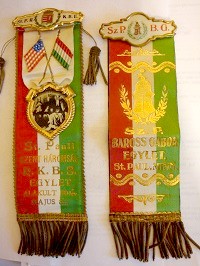 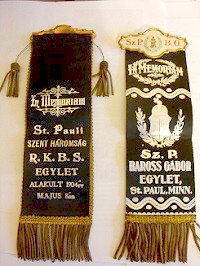 When
the owner of the badge died, the badges were to be worn or placed near them. The back side of
the badges (we have two different ones) were printed in silver with a black background. The
upper pins holding the badges can be removed and repinned to show either view. When
the owner of the badge died, the badges were to be worn or placed near them. The back side of
the badges (we have two different ones) were printed in silver with a black background. The
upper pins holding the badges can be removed and repinned to show either view.By reading the Hungarian words near the bottom of the longer banner, the association (EGYLET) was organized (ALAKULT) in the year 1904év (year), MAJUS (May) 8án (on the eighth = nyolcadik~án). I'm not able to help translate Sz (Saint) P. Baross Gábor (Gabriel) on this banner, nor Szent (Saint) Háromság, R.K.B.S. on the other. My husband is Richard Carl Fuith, whose father, Carl [Karoly in Hungarian], came to St. Paul in 1911, and mother, Marie Zambo Fuith, sister, and brother in 1921. Richard was born in St. Paul, MN, so, I believe they belonged to the Lodge sometime in the 20's up to the 70's. I was very surprised at how elaborate these two-sided badges were. Clearly, the colorful side was intended for membership recognition during life; and the black "In Memoriam" side as a final recognition. As you may suspect, I found Mary's information quite interesting and chose to follow-up, but first I'll note that if you click on the thumbnail images above, you'll get larger images, where the text is much easier to read. My first task was to translate the text on the badges. For this, I enlisted the help of Joe Jarfas, as the initials, R. K. B. S., on the one badge required some expert help to decipher. That badge, the one on the left of each image, reads (retaining the line breaks): St. Pauli Szent Háromság R. K. B. S. Egylet Alakult 1904 év Majus 8 án Joe proposed that R. K. B. S. likely stands for Római Katolikus Beteg Segélyzo. Further research by me suggests strongly that this is likely correct. This text translates most directly to Roman Catholic Sick-Relief (though we would most commonly say Benevolence in English rather than Sick-Relief. Thus the text on the left badge likely translates to: from St. Paul Holy Trinity R. K. B. S. [Roman Catholic Benevolence] Society Formed in year 1904 on May 8 The other badge was much easier: Sz. P. Baross Gábor Egylet St. Paul, Minn. It translates to: St. Paul Gábor Baross Society St. Paul, Minnesota Gábor Baross was a Hungarian statesman and Minister of the Interior who was mostly known for building the Hungarian railroads and making them economically viable. Many schools, parks, societies, etc. in Hungary were named for him, as was this society. Like the Holy Trinity Society, it was a self-insuring fraternal association, organized by Hungarians in St. Paul in 1892 (it folded in 1973). It provided sickness and burial insurance, along with Hungarian social interaction opportunities. As you might expect, the Holy Trinity Society was Catholic-based, whereas the Gábor Baross Society was not. Holy Trinity existed from 1904 until 1959. Both societies were mentioned in the 1981 book “They Chose Minnesota: A Survey of the State's Ethnic Groups,” edited by June D. Holmquist (partial pages found online via Google Books). Therein, Gábor Baross was called a ’Social and Sick Benefit Society.’ Its maximum membership was 114. Holy Trinity was said to be similar but its membership size was not cited in the available pages. According to the book text, by the 1950s the “sickness and burial insurance” purpose of the groups was no longer needed, so the groups were dying out; a last gasp was when they temporarily joined together to support the 1956 Hungarian influx into Minnesota and the US. By 1959, Holy Trinity had folded and the Hungarian Catholic League was started to replace its social and religious aspects. By 1965, the Catholic League spawned Minnesota Hungarians, created by a subset of members who wanted the social but not religious functions. This split caused the Hungarian Catholic League to wither away by the end of the 60s, so essentially all the remaining members of Holy Trinity, Gábor Baross, and the Hungarian Catholic League joined under the Minnesota Hungarians banner. Even then, membership was only in the lower 100s. The Hungarian Catholic League officially dissolved in 1977, but was moribund for a number of years before then.  Minnesota
Hungarians have a website at
http://minnesotahungarians.com/ wherein they claim both direct continuation from Gábor
Baross and, thus, 100+ years of existence. However, the book cited above says Minnesota
Hungarians started in 1965 and Gábor Baross did not shut down until 1973! Minnesota
Hungarians have a website at
http://minnesotahungarians.com/ wherein they claim both direct continuation from Gábor
Baross and, thus, 100+ years of existence. However, the book cited above says Minnesota
Hungarians started in 1965 and Gábor Baross did not shut down until 1973!Minnesota Hungarians wrote their first official by-laws in 1977, but rewrote them again in 1979 and changed their name to the ‘Hungarian Organization, Inc.’ due to internal disagreements; nonetheless, the rewrite caused many older members to drop out. Apparently the group eventually went back to the Minnesota Hungarians name and is still quite active. They provide on their website some additional background into some of these organizations (though it is hard to find!). In a reply to me, Joe Jarfas made a comment, to which I agree highly. He said: “…amazing what treasures can surface from time to time.” I thank Mary for sharing this treasure, both with me and the BB readership, and I invite you also to share your story should you have similar ethnic mementos or know that your family participated in these organizations. In a follow-up note to me, Mary writes that she and husband Dick now think that Dick's father, Carl Fuith, must have had the Boross Gábor badge and that Carl's wife, Mrs. Maria Fuith, must have been the member of the Holy Trinity Roman Catholic Benevolent Society, as she was the one who attended their meetings. They also speculate that the Holy Trinity records may be included in the St. Paul Archdiocese Historical records; if anyone ever visits those Archives, you might inquire. |
|||
5) FOLLOW-UP #2 TO "MARIA HOFFMANN HOTWAGNER" In Newsletter #231 (April 30, 2013), I wrote about the sons of Maria Hotwagner, one of whom, Joseph, was accused of treason during WW-II and sentenced to 10 years in prison in a subcamp of the Dachau concentration camp, barely avoiding being executed outright (he died in July 1945 of tuberculosis contracted in the camp). Four other prisoners were executed immediately (18 Dec 1942), as they were convicted of a higher offense, conspiracy to commit high treason: Johann Untenecker, Johann Balaskovics, Michael Balogh and Imre Kiss.  In
Newsletter #233 (June 30, 2013), I wrote a follow-up article because John Rajkovacz of
Muskegon, WI, questioned the timing of the death of Michael Balogh (he thought it was in Dec
1944). In answering John, I provided my sources (including an image of a notice published at
the time, see right) and also commented that: In
Newsletter #233 (June 30, 2013), I wrote a follow-up article because John Rajkovacz of
Muskegon, WI, questioned the timing of the death of Michael Balogh (he thought it was in Dec
1944). In answering John, I provided my sources (including an image of a notice published at
the time, see right) and also commented that:
John also mentioned the death of his grandfather's brother-in-law, Stefan Arth, but I had
no information about that.
Translated as:
As in the Nazi notice, Michael Balogh is listed as being from Schachendorf, Johann
Balaskovits from Dürnbach, and Johann Untenecker from Markthodis, though Emmerich Kiss is
listed as from Güns, and all were executed 18 Dec 1942. (I also copied the Stephen Arth
listing, as he was mentioned by John Rajkovacz when he wrote to me.) |
|||
6) HISTORICAL BB NEWSLETTER ARTICLES Editor: This is part of our series designed to recycle interesting articles from the BB Newsletters of 10 years ago. This month, I reprint one from NL 17 (August 15, 1997), mostly because the July 2003 edition was dominated by an index of the previous 20 editions and thus had few real articles to choose from. I considered selecting from the August 2003 edition but, like I intend to do next month, Gerry did not publish a newsletter that month (instead, he went to Europe for a boat trip from Amsterdam to Vienna via the Rhine, Main, and Danube rivers... me, I'll be in Ireland!) So, we go back to the first year of the BB and reprint one about Donauschwabians, a topic that compliments Article 3 above and the discussion of "'Ulmer Schachteln' Passenger Lists?" in Newsletter 232. THE BURGENLAND BUNCH NEWS No. 17 August 15, 1997 DONAU SCHWABIANS IN THE BURGENLAND If you think your people may have been part of the Danube Schwabian (DS) migration, you will be interested in this article extracted by Albert Schuch. Most DS migrated to the Banat of Yugoslavia, but some could have ended up in the Burgenland, as explained below. Summary of an article by Fritz Posch: "Schwabenzüge in die Steiermark", in: "Zeitschrift des historischen Vereins für Steiermark", 1952, p.98-112 In 1706, Count Franz Karl Kottulinsky married Baroness Maria Antonia Rottal and thus acquired the Styrian domains Neudau and Untermayerhofen, both situated at the Hungarian border (10 kms northwest of Stegersbach). Most villages of these two domains were looted and torched by the "Kuruzzen" in 1704, 1707 and 1708. The loss of population was not that heavy, for most people were able to hide in the woods. Since this was the time of the first large-scale German colonisation of Hungary (usually areas to the east and south-east of Burgenland), Count Kottulinsky made - probably by chance - contact with a group of emigrants, mostly "Schwaben" from the Bodensee-area, in early Sep 1712. He met them in Vienna on their way to Hungary. (They were traveling on the river Danube.) It can be assumed that they had already signed contracts with a domain owner in Hungary. Nonetheless Count K. managed to persuade 12 families (63 persons) to settle in his Styrian domains. On foot they marched from Vienna (11 Sep) to Neudau (16 Sep). They all came from the Bodensee-area and they carried documents and passports showing that they were heading for Hungary. These documents were made out between 13 Jul and 12 Aug. Martin Scherer, from St. Peter in the Schwarzwald, described his journey: He had marched 20 miles to the city of Ulm, where they had boarded the ships that carried them 180 miles down the river Danube, for which they were charged 5 Gulden and 4 Kreuzer per person. Most of these people left soon for Hungary, but some did stay, including the Martin Scherer mentioned above. He traveled to his home village in Dec 1712 and successfully persuaded others to come to Neudau too. By the end of April 1713, a group of emigrants left for Neudau, which they reached on 22 May. In June 1713, Martin Scherer left for his homeland for the second time. He left the Schwarzwald with new emigrants. They traveled via Passau (9 Aug), Gmunden (14 Aug), Bad Ischl (15 Aug), Aussee (16 Aug), Rottenmann (20 Aug), Leoben (22 Aug), Weizberg (26 Aug). On Aug 29 the 10 families (59 persons) arrived in Neudau. The emigrants are described as decent and honest people who left their homes because of high taxes and inflation (caused by war), also because of overpopulation. In 1713, at least 24 families arrived in Neudau. But they did not find the "promised land" and so, by the spring of 1714, some of them had already left again. Finally, only 12 families stayed. The settlers remained in touch with their homeland (visits, letters). In 1717, a group of the "Schwaben" left, all the remaining did so overnight in 1723. It is supposed that they went to Hungary, were they were expecting better conditions. A settlement of some of these "Schwaben" in southern Burgenland must be considered possible for geographical reasons (though I think it is more likely they went further to the (south) east). I add all the family names mentioned. Details (age, origin) can be provided from the article [rearranged alphabetically]: Andres, Brechter, Dilger (Dillinger), Dolt, Drescher, Erner, Fallenthor, Fehrnbach, Fuchs, Gerer, Grabher, Häbding, Helbok, Heutz, Holtzmann, Hug, Krotz, Kuenle, Leibinger, Löffler, Lökhert, Lorinser, Lutzenberger, Mercklin, Messmer, Nagel, Paumann, Pfaff, Pfündler, Reichart, Relly (Rely, Reily), Riether, Rohrer, Rusch, Sandholzer, Saumb, Scherer, Scherzinger, Schoblach, Schuller, Schwarz, Schwerer, Stiering, Teusch, Waldvogel, Werthmüller. |
|||
7) ETHNIC EVENTS LEHIGH VALLEY, PA (courtesy of Bob Strauch) Friday-Sunday, August 2-4: Parish Festival at St. Francis of Assisi Roman Catholic Church in Allentown. Polka Mass Sat. at 4:30 PM. Music by the Walt Groller Orchestra (Fri) and the Emil Schanta Band (Sat). Sunday, August 4: 59th Parish Picnic at St. Peter’s Roman Catholic Church in Coplay. Polka Mass at 10:30 AM. Music by the Emil Schanta Band and the Joe Weber Orchestra. Sunday, August 18: German-American Day at the Evergreen Heimatbund in Fleetwood. Music by the Josef Kroboth Orchestra. Info: www.evergreenclub.org. Saturday, August 24: Biergarten at Emmaus Community Park. Sponsored by the Lehigh Sängerbund. Music by The Jolly Bavarians. Info: www.lehighsaengerbund.org Saturday, September 7: Northampton-Stegersbach Sister City Celebration at Northampton Borough Park. Music by the Walt Groller Orchestra. Sunday, September 15: Oktoberfest at the Coplay Sängerbund. Music by the Josef Kroboth Orchestra. Info: www.coplaysaengerbund.com. Sunday, September 29: Oktoberfest at Holy Family Club in Nazareth. Music by the J & J Orchestra. Info: www.holyfamilyclub.com. LANCASTER, PA Sunday, August 4, Noon to 6 pm: Liederkranz Club Picnic ($5 / $12 Guests). Barbeque buffet served Noon to 1:30 pm. Annual Horseshoe Tournament. Entertainment by Hans & Accordion. Saturday, August 10: Smokin' Blues & Brews Fest. Lancaster Liederkranz ($35 / $15 for designated drivers). 2 Sessions: 1-4:30 & 5:30-9 pm. Smoked Meats, Live Blues Bands, Beer Tastings from 20 breweries! Friday-Sunday, September 20-22: Oktoberfest at the Lancaster Liederkranz. Info: www.lancasterliederkranz.com. NEW BRITAIN, CT Friday, August 2, 7 pm: Heimat Abend. Austrian Donau Club, 545 Arch Street, New Britain, CT (860 223-9401). Music by Joe Rogers. Friday, August 16, 7 pm: Heurigan Abend. Austrian Donau Club. Music by Schachtelgebirger Musikanten. ST. PAUL, MN Sunday, August 25: Upper Midwest BB Group Picnic at the German/American Institute in St. Paul. |
|||
8) BURGENLAND EMIGRANT OBITUARIES (courtesy of Bob Strauch) Ed. Note: For the first time since I became Editor of the BB Newsletter (3+ years ago), we have no obituaries to report for emigrants to America from Burgenland. It was my expectation that this void would occur eventually, as emigration from Burgenland has been miniscule since 1938 (except for a small burst between 1955 and 1960, after the Soviets pulled out of Austria). Even the youngest emigrants from before WW-II would be 75+ now. Thus, the number of surviving emigrant Burgenländers must be shrinking rapidly, so deaths each month are likewise fewer. For some time, I have been expecting we would be seeing a month without obits—and it seems it finally showed up—and I expect also that this will become less and less unusual over the next 10 years! However, Bob Strauch suggests the decline may also have to do with the diminishing length of obituaries (due to increasing cost) so less detail, such as place of birth, is published. Bob uses specific search parameters to detect appropriate obituaries and, if the required information is not in the obit, the obit is not flagged. In addition, he suspects that fewer newspapers are being indexed by the indexing services, again likely as a cost-cutting measure. Since we have no obituaries, I will note a recent significant death, though neither a Burgenländer nor an emigrant to the US: Gyula Horn, born July 5, 1932, in Budapest, died June 19, 2013, also in Budapest. He became a hard-line Communist after WW-II (his father, also a Communist, was executed by the Nazis during the war) and served in government militia units during the 1956 revolt. He joined the Foreign Ministry in 1959, serving as a diplomat in Bulgaria and Romania before becoming deputy foreign minister in 1985 and foreign minister in 1989. With Moscow's power waning in Eastern Europe, he became a nonideological reformer, helping lead Hungary away from Communism. Eventually, he was elected prime minister in 1994.  However,
what he will likely be remembered for most is embodied in the picture shown here. Along with
Alois Mock, the Austrian foreign minister, he (symbolically) cut the Iron Curtain along the
Burgenland border on June 27, 1989. Of significance, the stunt provoked no reaction in the
Soviet Union, despite its many troops stationed in Hungary. Three weeks later, several hundred
East Germans crossed into Austria during a picnic on the border. Another three weeks later,
Horn announced on Hungarian television that East Germans were free to cross the border. Within
two months, the Berlin Wall was breached and Communist dictatorships began to fall. However,
what he will likely be remembered for most is embodied in the picture shown here. Along with
Alois Mock, the Austrian foreign minister, he (symbolically) cut the Iron Curtain along the
Burgenland border on June 27, 1989. Of significance, the stunt provoked no reaction in the
Soviet Union, despite its many troops stationed in Hungary. Three weeks later, several hundred
East Germans crossed into Austria during a picnic on the border. Another three weeks later,
Horn announced on Hungarian television that East Germans were free to cross the border. Within
two months, the Berlin Wall was breached and Communist dictatorships began to fall.Alois Mock, age 79, still survives and was recently honored by having the "Dr. Alois Mock" Austrian Library in Zadar, Croatia, named after him. Mock was influential in Austria’s admission to the European Union in 1995 and was a key figure in the process of shaping Croatia’s independence. |
|||
END OF NEWSLETTER |
|||
NOTICE (Terms and Conditions): The Burgenland Bunch (BB) was formed and exists to assist Burgenland descendants in their research into their heritage and, toward that end, reserves the right to use any communication you have with us (email, letter, phone conversation, etc.) as part of our information exchange and educational research efforts. • If you do not want your communication to be used for this purpose, indicate that it is "confidential" and we will abide by that request. • Correspondents who communicate with the BB without requesting confidentiality retain their copyright but give a non-exclusive license to the BB allowing us to forward to BB members, publish in our monthly newsletter or on our website, and/or subsequently and permanently archive all or parts of such communications. The Burgenland Bunch homepage (website) can be found at: http://www.the-burgenland-bunch.org/ Burgenland Bunch Newsletter, copyright © 2013 by The Burgenland Bunch All rights reserved. Permission to copy excerpts granted if credit is provided. |
 News
News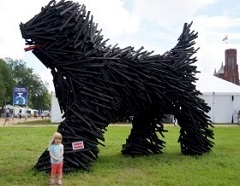 THE
SMITHSONIAN FOLKLIFE FESTIVAL'S BIG DOG: The Smithsonian Folklife Festival, held
Wed-Sun, June 26-30 and July 3-7, had Hungarian Heritage: Roots to Revival, as
one of the featured programs. One curiosity related to that program is shown in the picture to
the right.
THE
SMITHSONIAN FOLKLIFE FESTIVAL'S BIG DOG: The Smithsonian Folklife Festival, held
Wed-Sun, June 26-30 and July 3-7, had Hungarian Heritage: Roots to Revival, as
one of the featured programs. One curiosity related to that program is shown in the picture to
the right.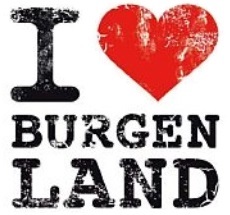 FESTIVALS
IN BURGENLAND: Since we are talking of festivals (Stiftungfest, Smithsonian
Folklife Festival), I might as well throw in something about the upcoming festivals in
Burgenland.
FESTIVALS
IN BURGENLAND: Since we are talking of festivals (Stiftungfest, Smithsonian
Folklife Festival), I might as well throw in something about the upcoming festivals in
Burgenland.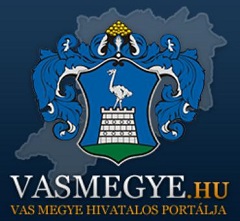 German
& Croat Minorities in Present-Day Vas County, Hungary: Staff member Margaret Kaiser
shared an interesting, English-based link,
German
& Croat Minorities in Present-Day Vas County, Hungary: Staff member Margaret Kaiser
shared an interesting, English-based link, 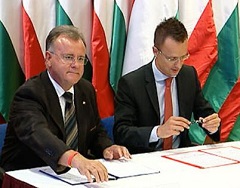 Burgenland/Hungary
Cross-Border Transportation Projects: Margaret Kaiser also shared a note about
a recent agreement between Burgenland and Hungary. On July 17, the Hungarian Foreign Trade
Secretary, Péter Szijjártó, and the Burgenland Governor, Hans Niessl, signing a declaration of
intent to develop more/better transportation ties. The document they signed will provide for
the creation of feasibility studies for such projects, which potentially include both road and
rail improvements. Money to support this effort would come from European Union funds available
in the 2014-2020 budget period.
Burgenland/Hungary
Cross-Border Transportation Projects: Margaret Kaiser also shared a note about
a recent agreement between Burgenland and Hungary. On July 17, the Hungarian Foreign Trade
Secretary, Péter Szijjártó, and the Burgenland Governor, Hans Niessl, signing a declaration of
intent to develop more/better transportation ties. The document they signed will provide for
the creation of feasibility studies for such projects, which potentially include both road and
rail improvements. Money to support this effort would come from European Union funds available
in the 2014-2020 budget period. 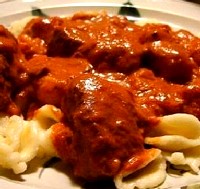 5
Tbsp. fat 1
Tbsp. vinegar
5
Tbsp. fat 1
Tbsp. vinegar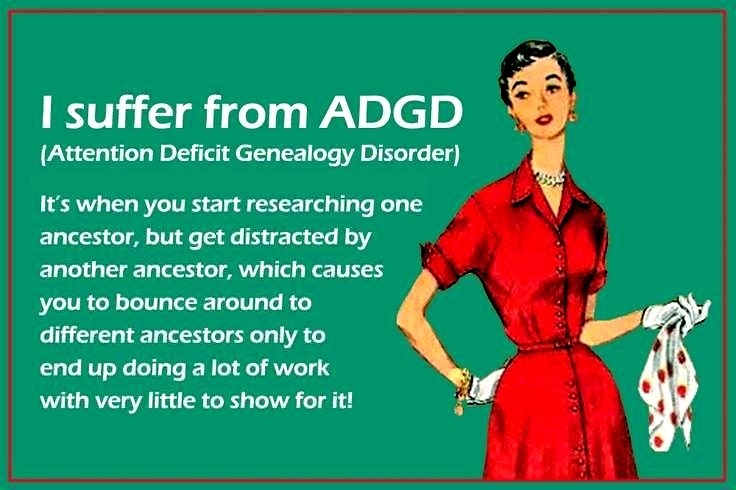
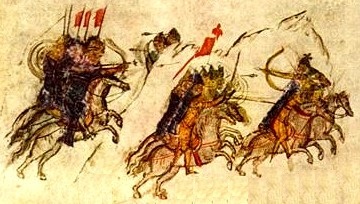 Likewise,
I thought the Hungarians were actively at war against the Pechenegs on their Eastern border at
that time… so why would they use them on their Western border? I’m sure there were mercenaries
of all ilk who could be “hired” to defend borders, but these seem odd choices. As for the
Székelys, these seem more Magyar than anything else. I’ve read various arguments that they
were “in-law” tribes or, contrarily, just Magyars assigned to border-guard duty… the name
Székely is said to be derived from an early Magyar word for border guard (though I could
see the possibility that the Magyar word was derived from the name of the people doing it…
hard to say whether it was the egg or chicken that came first here!) Anyway, I’d be interested
in your thoughts (you too, Bob) on the nature of these observation forces and my concerns
about their composition. As I said originally, one would expect that the people used were
considered trustworthy by the Magyars… putting your enemies there seems counterproductive.
Likewise,
I thought the Hungarians were actively at war against the Pechenegs on their Eastern border at
that time… so why would they use them on their Western border? I’m sure there were mercenaries
of all ilk who could be “hired” to defend borders, but these seem odd choices. As for the
Székelys, these seem more Magyar than anything else. I’ve read various arguments that they
were “in-law” tribes or, contrarily, just Magyars assigned to border-guard duty… the name
Székely is said to be derived from an early Magyar word for border guard (though I could
see the possibility that the Magyar word was derived from the name of the people doing it…
hard to say whether it was the egg or chicken that came first here!) Anyway, I’d be interested
in your thoughts (you too, Bob) on the nature of these observation forces and my concerns
about their composition. As I said originally, one would expect that the people used were
considered trustworthy by the Magyars… putting your enemies there seems counterproductive.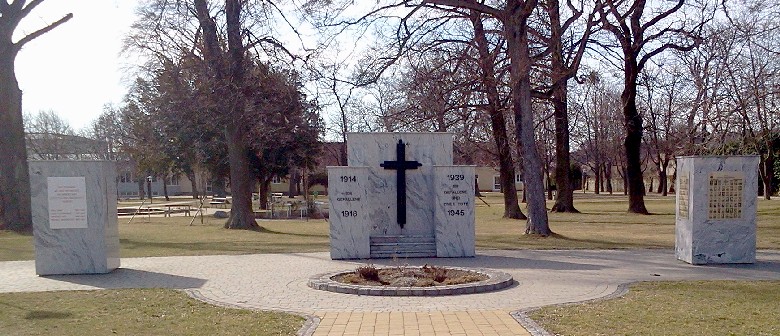
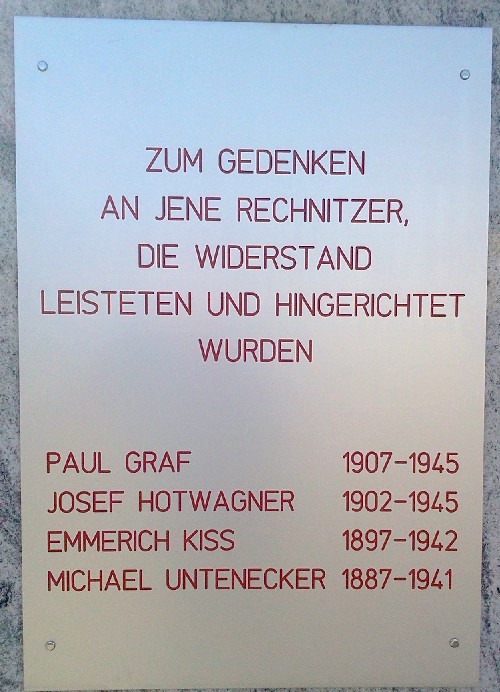 [The
Front (Resistance Fighters) Plate is shown to the right. Thomas gives the German text
and his translation (for both this and for the other plates)]:
[The
Front (Resistance Fighters) Plate is shown to the right. Thomas gives the German text
and his translation (for both this and for the other plates)]: